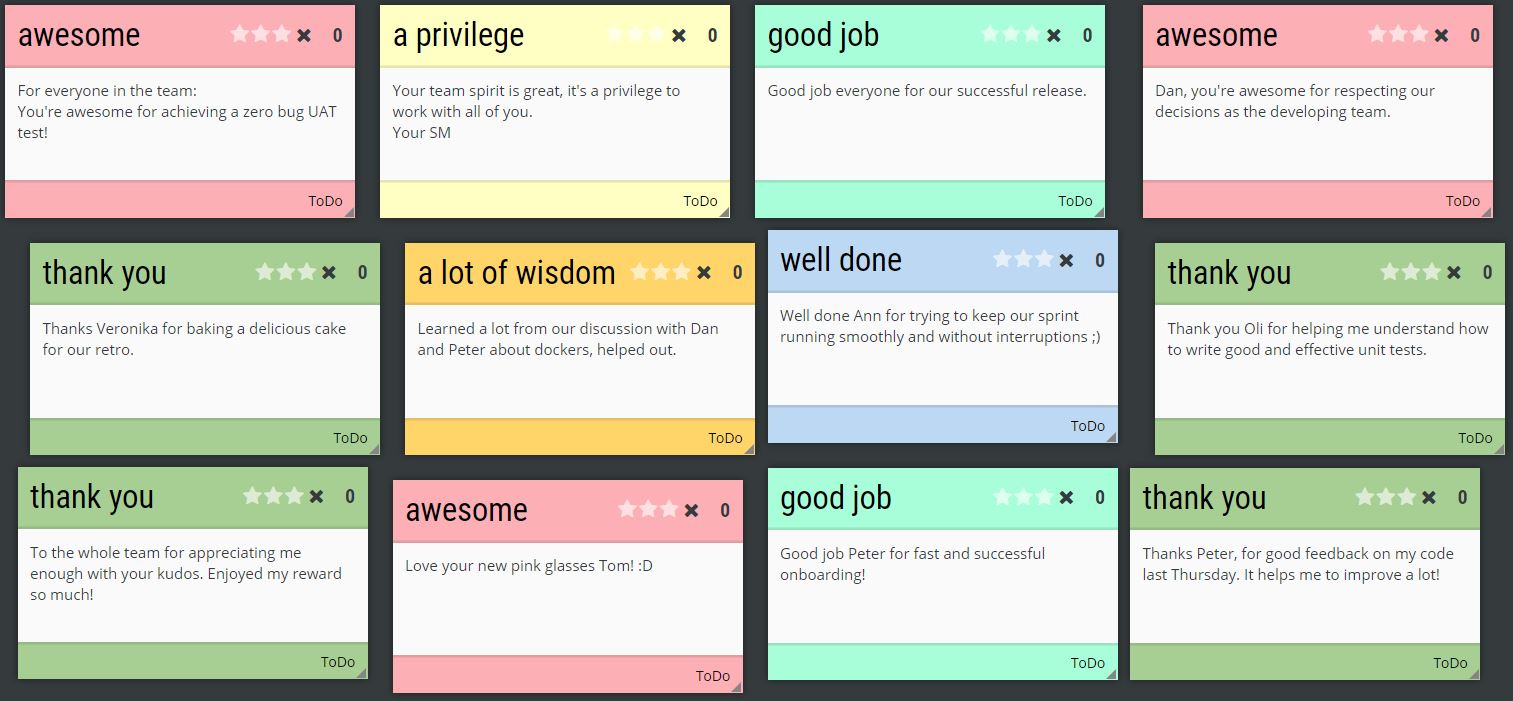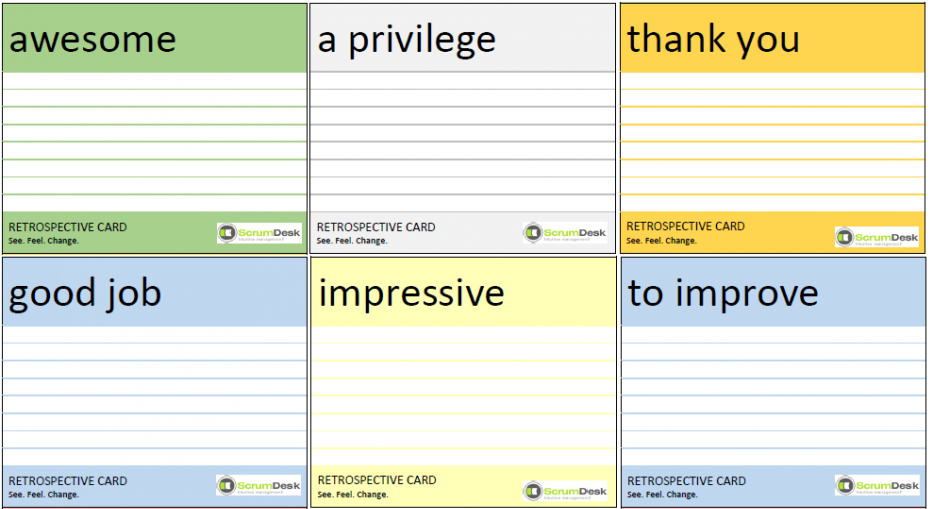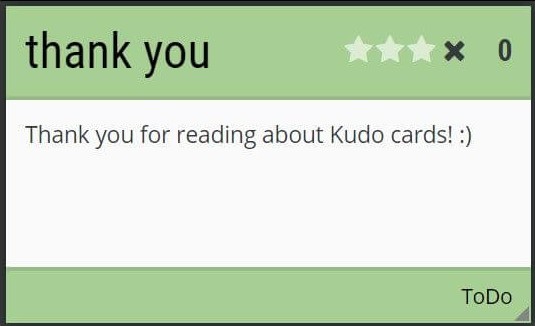Being agile means receiving feedback, accepting it and changing. To get feedback you probably do retrospective once a sprint, but there are other activities that can provide ideas at any time, motivate and “spice up” your retro all at once. We’re talking about Kudo cards.
 Kudo cards is a technique described in Management 3.0 designed to help deliver feedback and motivate people in the right way. The word “kudo” comes from Greek and means “praise”, which is exactly what Kudos are meant for. They are small cards with predefined text like “Thank you”, “Awesome”, “To improve”, that help you show gratitude or give fair criticism to a coworker.
Kudo cards is a technique described in Management 3.0 designed to help deliver feedback and motivate people in the right way. The word “kudo” comes from Greek and means “praise”, which is exactly what Kudos are meant for. They are small cards with predefined text like “Thank you”, “Awesome”, “To improve”, that help you show gratitude or give fair criticism to a coworker.
Anyone can write a Kudo and dedicate it to anyone, you can even make one for the whole team. Kudo cards can be anything you want them to, you can make them a little more serious or use them as a fun activity with some jokes between coworkers. They should make life in the office a little more interesting.
Kudo cards create space for the team to decide how they want to give and receive feedback and are in general a great activity to motivate disengaged teams.
Kudo cards present a simple way to break the traditional hierarchical organizational structure in company. Receiving a Kudo can motivate and shows appreciation.
An important part of exchanging Kudo cards is showing gratitude and giving credit. It doesn’t seem like saying a simple “thank you” to someone might be difficult, we still struggle to do so. Reasons causing this may vary; lack of time, not wanting to bother or we just simply don’t realize what effect a simple thank you can have. Kudo cards help you break this barrier and teach you how to give gratitude.
Why are Kudo cards better than financial reward
Typical association “reward = more motivation” is something we are taught from elementary school, but it often results in caring more about the grade than about understanding the subject. Companies use financial rewards as means of motivation, trying to make their employees work faster and be more effective. This model implied by associative learning found in most animals, is proving to be ineffective. A study from Workforce institute at Kronos Incorporated showed that over 70% of employees felt more motivated after receiving financial reward only for less than 6 months. However, a simple “thank you” gave the feeling of satisfaction to 70% of interviewed employees. Study indicates that small everyday displays of gratitude and appreciation are more important and effective than financial rewards or expensive gifts. Similar findings were shown by Julia Hur and Loran Nordgren in an experiment aimed at effects of reward on performance. In this case researches showed that when participants anticipated a reward, their attention shifted from the task itself to the reward. They cared more about the outcome than the process and were willing to use shortcuts and other undesirable practices.
Can you motivate people without side effects?
IT industry is often viewed as something boring, but more and more people break the stereotype showing that developing any application takes a lot of creativity. In the book Drive, Daniel Pink shows that in creative industries, like IT, people are more motivated by Purpose, Autonomy and Mastership, rather than money. So how can you motivate people in an industry like this?
First, people defining the work should think about:
- purpose of the job (project and product vision, goals, knowing the client and their needs),
- team organization (self-organizing teams, pull system, continuous improvement),
- creating space for self-improvement (architecture, new technologies, tools, authority to decide how to implement a solution).
In general, rewards should make the team feel appreciated and accomplished. These types of rewards, referred to as intrinsic (internal) rewards shouldn’t be centered around expensive gifts, but should be about something that makes us feel good and successful in our task. Something that strengthens the feeling of purpose in what we do. Money and financial rewards are still important, but if your goal is to motivate people and boost their interest and creativity, they shouldn’t be a priority.
We often see how surprised people get after realizing what the small things they do mean to others.
This is where Kudo cards come in place, they work as great intrinsic rewards. Giving honest feedback to a coworker should make them feel appreciated and like their job has a point. They’re designed to reward the process, not just an outcome. Anyone can write a Kudo card and anyone can receive one at any time, which makes them suitable as a long-term motivational technique without the need for big financial or time investment.
According to Jurgen Appelo, intrinsic rewards that don’t affect motivation negatively should meet these few rules:
How to: retrospective, Kudo box and Kudo wall
If you want to try Kudo cards in your team, we recommend getting the management involved and securing a small budget for rewards (remember, any reward should be kept small so don’t panic about the budget). Explain why you want to use Kudo cards, their advantages and possible long-term effect they can bring. Or you can try suggesting Kudo cards after you do a small test run on few retrospectives and have some positive feedback from the team.
Introduce Kudo cards to your team during retrospective and be sure to explain not only what the cards are, but what they can bring to them and what you want to achieve by introducing this practice. At first, discuss with your team what they value on each other in general and how it contributes to the team’s work. This should make everyone realize what they appreciate and make it easier to write a card. Next, ask them to choose a card and write a Kudo (download blank cards here). Don’t forget you yourself should write a card too! Decide with your team if you want to sign your cards or write them anonymously. Afterwards, collect the cards, read each card out loud in front of the team and give it to its receiver to keep as a small token of appreciation. Reading Kudos in front of everyone is a very important part of the activity, it shows what the team values and should make the process of being recognized a little more special.
If you get positive feedback on this small “Kudo introduction course”, try the next thing – Kudo box. It’s a simple box (you can use a decorated shoe box) in which people can store their Kudos until they’re read, for example, once a sprint. Kudo box makes it possible for people to write a card anytime and creates even more opportunities for people to give feedback. Read the cards just like before, in front of everyone and deliver them to their recipients. Invite your boss to participate in the reading, his cooperation will affect the practice positively.
In this stage, you shouldn’t forget to reward people for receiving a Kudo card. If you want to use Kudo box as a long-term motivation technique, the appraisal should be followed up by a small reward. Using small gifts will make people want to participate a little more and will intensify the feeling of appreciation after receiving a Kudo at the same time. Keep in mind the gift should be small to avoid negative effects on motivation. Examples of good rewards include movie tickets, lunch invitation or a day off. Choose a reward based on your possibilities and your team. If you want to make Kudos more fun and engaging for the team, let them decide what gifts to get for each other, and remember – gag gifts and little jokes are welcomed.
Another way to make Kudo box more interesting is a Kudo wall. Reserve part of a wall for displaying Kudo cards. After someone receives a Kudo, they can put it up on the wall and take pride :). Kudo wall is another way to increase the positive effects of Kudos, both by keeping them in sight at all times and making them public. Everyone who passes the wall might notice and read how good your team is! Maybe they might get inspired to write a card for someone on the team or start the activity in their own team.
Kudo wall can be used not only for giving feedback and showing appraisal. It’s a great tool to collect ideas during the whole sprint, not just during retrospective.
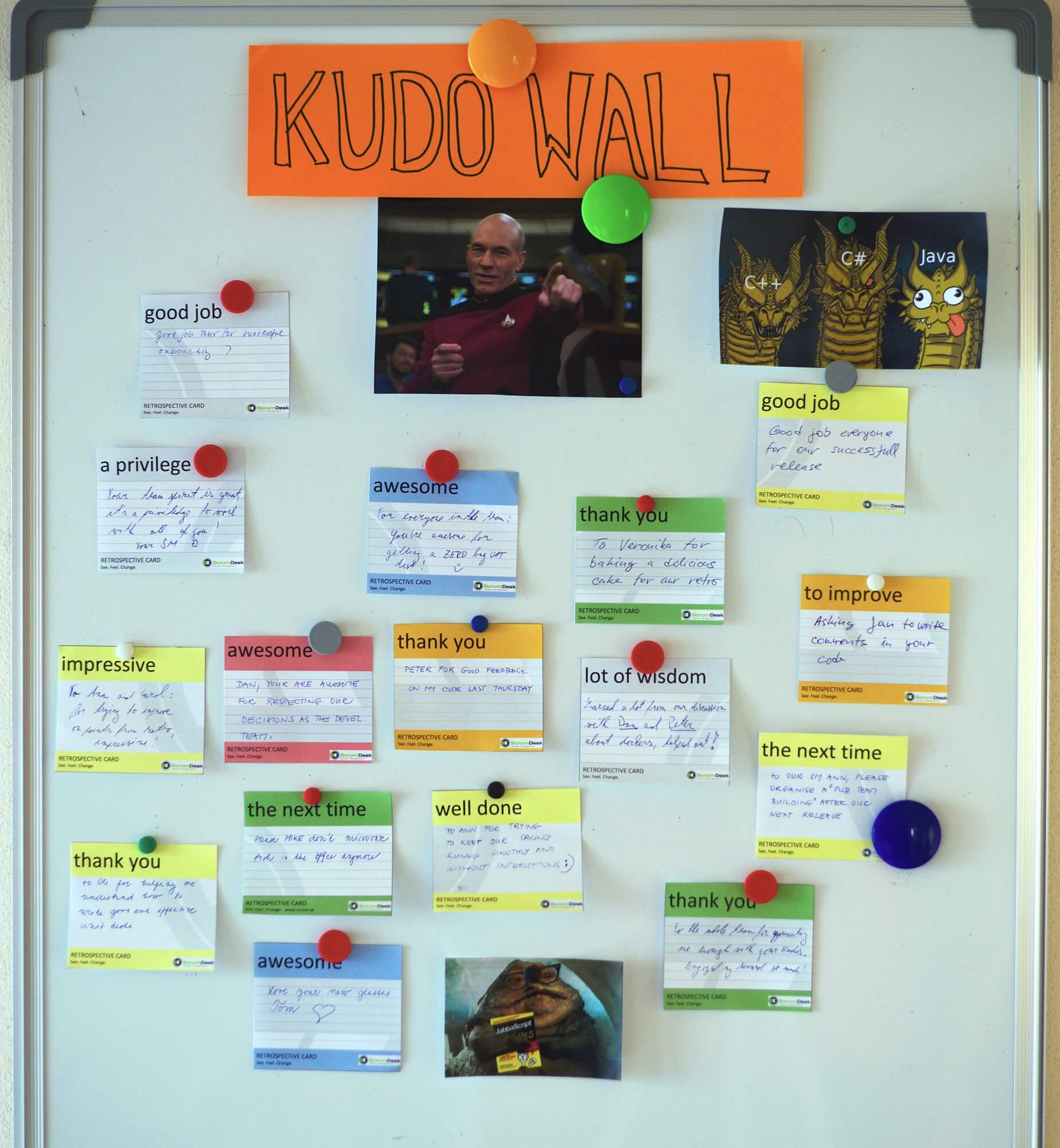
This is what your Kudo wall can look like
How big corporations do it
Multinational corporation we worked with during Agile mentoring practiced Kudo wall too! They did so in a very simple way – people wrote their Kudos on a traditional blackboard with a chalk. CEO and management read the Kudos once a month and people tagged in messages got a day of vacation as a reward. They also made sure people writing Kudos weren’t left out and invited the person writing lot of Kudos for lunch. Naturally jokes like “I’m the tallest one here, so I should get one more day off.” started appearing on the wall. Management wasn’t sure what to do about this type of messages, but it turned out even this pulled people to the wall and made it more desirable to give feedback. It proved that management is really serious about being transparent and isn’t trying to censor anything, so much so that clients had access to this wall too.
Tips for introducing Kudo cards in your team
Starting with Kudo cards in your team doesn’t have to be easy. If you believe this technique will bring something valuable, these few tips should help you jump through obstacles and get everything set (semi)smoothly:
Don’t forget that this practice is about your team. Adjust it to their needs and how you deem necessary. Don’t be afraid to change the rules. Do you think it would be better for your team to sign the cards and not write them anonymously or just use them for you retrospective, not long term? Go for it!
Create your own Kudo wall in ScrumDesk
For distributed teams or for someone who wants to try Kudo cards on retrospective without printing the cards (and save the rain forest), use a way to do this technique online. Try it in ScrumDesk’s module RetroDesk, in which you can make a whole Kudo wall online. Additionally, you can connect any other activity to a card and plan them into sprints. You can also connect them to project goals and show your efforts to everyone.
How to start?
- Open your project in ScrumDesk and select “RETRO” from the main menu on the left.
- Switch the view to “Retro Desk”.
- You can choose to create the wall for a certain sprint or simply click “All sprints” to avoid tying Kudos to one sprint.
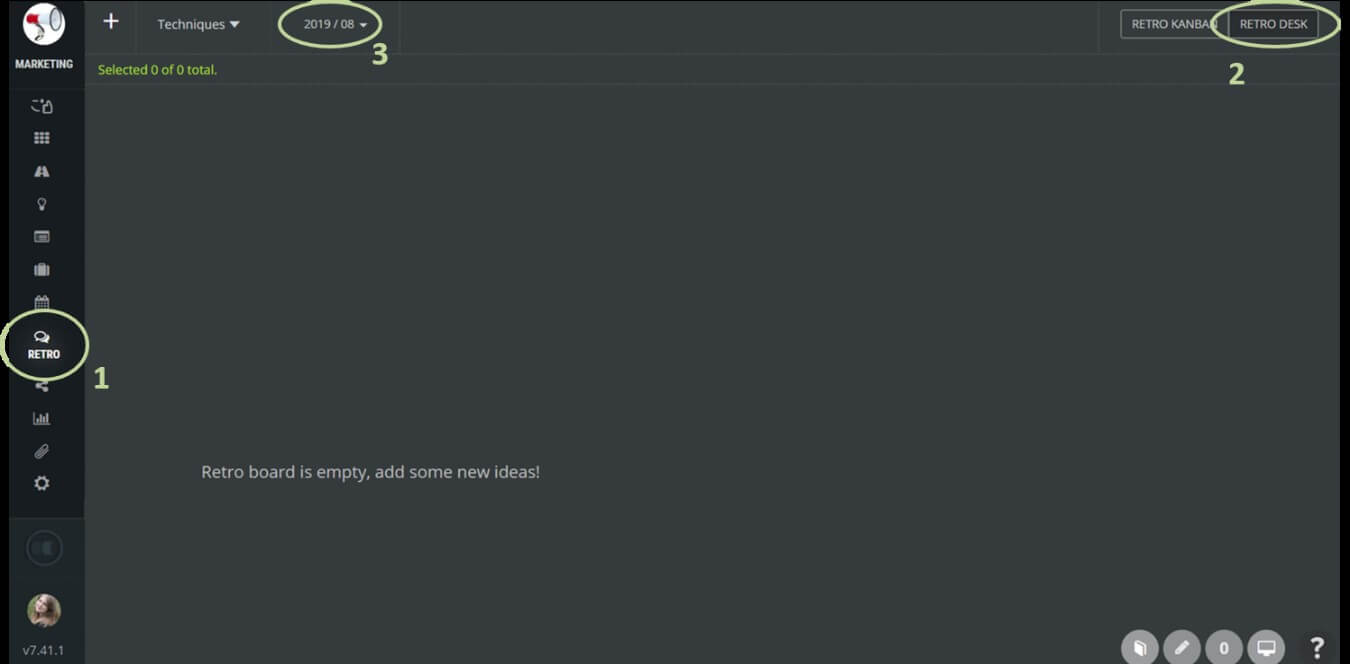
- Open “Techniques” and choose “Kudo cards ” from the drop-down menu.
- Drag the card you want to use and write your Kudo. Click the tab “Relations” to connect the card to other activity in ScrumDesk or click “Comments” to add a comment.
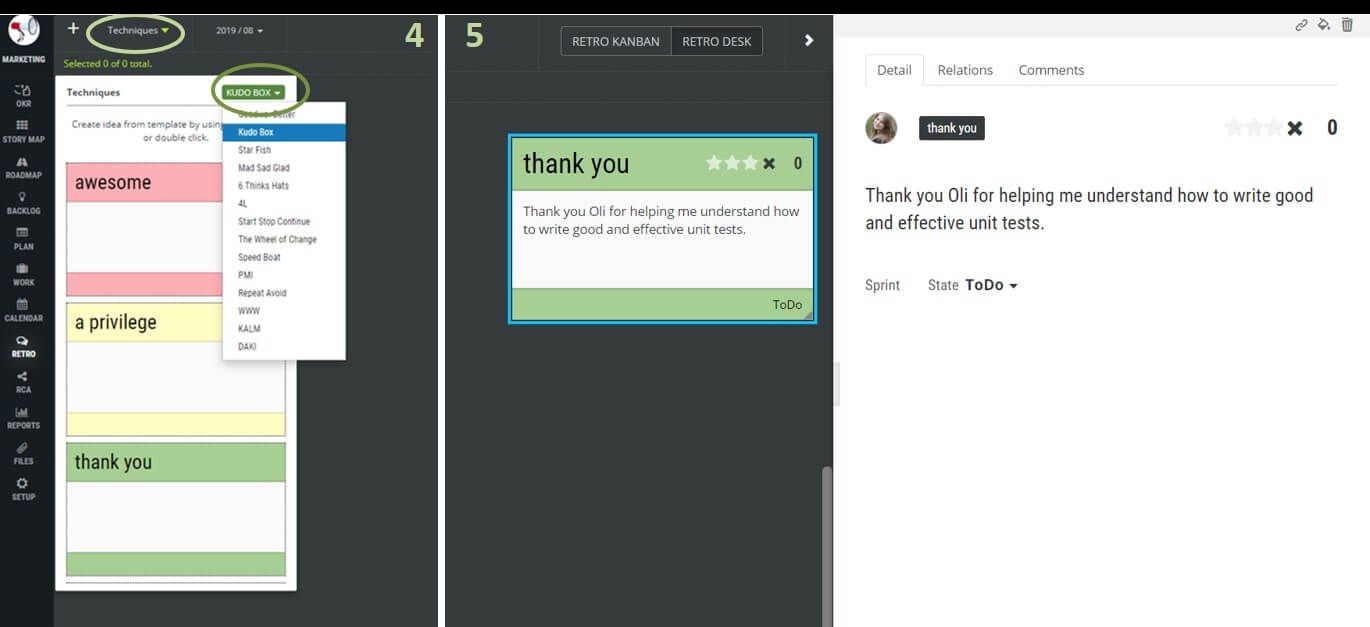
Should you try Kudos?
Definitely! Implementing Kudo cards might pose some a challenge, but the results will be well worth it. Try this technique if you need to motivate disengaged team. Make the retrospective a little different or if you want to motivate your team the right way. Kudo cards will help you create culture of gratitude and will make the people in your team feel appreciated for their hard work. You can star right now by downloading blank Kudo cards here!

